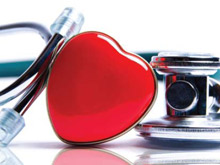Health Topics
-
Healthy Living
-
|
|
March 2010
|
Heal Your Heart - II
Cardiac Rehabilitation Programme |
| Dr P Srikanth |
| |
 |
Here is a medically supervised programme to help heart patients recover quickly and improve their overall physical, mental and social functioning. The two part series concludes |
A cardiac rehabilitation programme helps you to understand and reduce your risk factors of heart disease. You will learn how to manage your condition with healthy diet, and develop a safe exercise programme that will return you to optimal physical condition. Your stress and anxiety levels would also be brought down, helping you rebuild a healthy lifestyle. This programme is recommended for those who have had either angina, heart disease, bypass surgery, or angiography showing blockage. Those who have had angioplasty (stent), heart valve surgery or heart transplant surgery would also be benefitted by this.
There are four phases of cardiac rehabilitation. The first two were discussed in the February 2010 issue of B +ve. Phase I was a week-long programme that started when the patient was in the hospital, aimed to reduce the deconditioning effect of prolonged bed rest. The three-weeklong Phase II was to start once the patient was discharged from hospital and continued at home, or even in a clinic. It aimed to improve functional capacity and lower cardio-vascular risk factors. But before we move to the exercises in Phases III & IV, there are a couple of things that need to be sorted outside a gym.
Emotional Health
Psychological factors increase the risk of getting heart disease or making it worse. Depression, anxiety and anger are common among people who have heart disease or have had a heart attack or heart surgery. Get treatment if you feel sad, anxious, angry, or isolated. These feelings can affect your physical recovery. Depression is linked to complications, such as irregular heartbeats, chest pain, a longer recovery time, the need to return to the hospital, and even an increased risk of death.
Seeking help is important. Group or individual counselling helps lower your risk for future heart attacks and death. It may also motivate you to exercise and help you relax and learn how to reduce stress. People with heart disease, who get mental health treatment often show improvements in blood pressure, cholesterol, and other measures of physical health.
Your rehabilitation team, that is helping you bounce back from a heart surgery should include a mental health specialist (or someone from the team may be able to refer you to one). Without help from a professional, these problems may not go away. Some communities have support groups for people who have had heart attacks or heart surgery. They may also have walking groups or exercise classes. Help with basic needs and transportation also may be available.
Sexual Dysfunction Counselling
People who have heart problems sometimes have sexual problems. The most common problem is less interest or no interest in sex. Impotence or premature or delayed ejaculation may occur in men. Depression, medicines, fear of causing a heart attack, or diabetes can contribute to sexual problems.
Sexual activity often is safe for low-risk patients. The maximum heart rate during usual sexual activity is similar to other daily activities, such as walking up one or two flights of stairs. Do talk to your doctor if you’re having sexual problems.
PHASES III & IV
Phase III starts within six weeks of the patient being discharged from the hospital. It stretches to 12 weeks, and is a community based programme. Phase IV concerns itself with community based maintenance. Phase III aims to improve the physical status of the recovering person. It has a continuous emphasis on patient education and risk factor modification. Phase IV meanwhile, is about monitoring and maintaining the results achieved during the early phases. The exercises in these phases have a functional capacity of more than 5 METS (Metabolic Equivalents), which means that they could include swimming, cycling etc.
Group or individual counselling may also motivate you to exercise and help you relax and learn how to reduce stress
Upper body workout, with a one kg dumbbell
Shoulder
Front & back dumbbell lifts
3 sets; 10 reps
Rest period: 5 min between exercises
Butterfly dumbbell lifts
3 sets; 10 reps
Rest period: 5 min between exercises
Inner & outer dumbbell lifts
3 sets: 10 reps
Rest period: 5 min between exercises
Biceps curls
3 sets; 10 reps
Rest period: 5 min between exercises
Triceps curls
3 sets; 10 reps
Chest workout, with a one kg dumbbell
Flat bench lifts
3 sets; 10 reps
Rest period: 5 min between exercises
Inclined flying
3 sets; 10 reps
Rest period: 5 min between exercises
Declined pressing
3 sets; 10 reps
Rest period: 5 min between exercises
Lower body work out
Leg lifts
3 sets; 10reps
Rest period: 5 min between exercises
Leg press
3 sets; 10 reps
Rest period: 5 min between exercises
Leg side raises
3 sets; 10 reps
Rest period: 5 min between exercises
Leg front raises
3 sets; 10 reps
Rest period: 5 min between exercises
The weights would be increased as the patient’s exercise tolerance level increases. |
 |
Dr. P. Srikanth is Sr. Physiotherapist, Apollo Wellness Plus, Hyderabad |
|
|